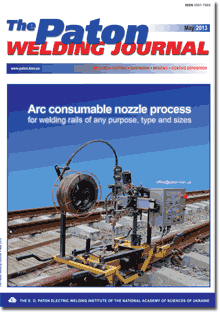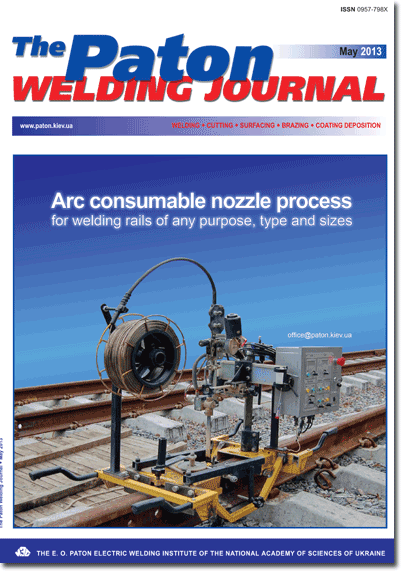| 2013 №05 (03) | 2013 №05 (05) |

The Paton Welding Journal, 2013, #5, 29-38 pages
ON PLANNING OF REPAIR OF PRESSURISED MAIN PIPELINES BASED ON THE RESULTS OF IN-PIPE DIAGNOSTICS
A.S. MILENIN
E.O. Paton Electric Welding Institute, NASU, Kiev, Ukraine
Abstract
The world and national practice of operation of land main pipelines shows the trend to utilisation of different methods to repair them by welding without any interruption of transportation of a product. Planning of a certain repair method, which is an important stage of ensuring the efficiency and safety of restoration of a carrying capacity of defective regions in main pipelines, requires development of appropriate methodological principles for analysis of damage of a structure, estimation of admissibility of operation and prediction of remaining life. This study suggests a multilevel procedure for numeric analysis of results of in-pipe diagnostics of the state of linear parts of main pipelines, allowing for the specific character of repairing them without removal from service, and permitting optimisation of repair-and-renewal operations in lengthy regions of a pipeline on the basis of numeric ranking of defects of a different nature. It is suggested using different levels of ranking depending on the available data of technical diagnostics of the state of a specific linear region of a main pipeline: based on subdivision of all defects into admissibility groups by estimating the remaining safety factor in a region of a specific defect, or by calculating the probability of violation of integrity of a pipeline wall. A differing degree of conservatism of the suggested procedure depending on the completeness of the source data makes it possible to analyse the results of in-pipe diagnostics at the required accuracy and effectively plan removal of the detected defects by the methods of repair of pipelines without withdrawing them from service. 12 Ref., 10 Tables, 5 Figures.
Keywords: main pipeline, repair without removing from service, in-pipe diagnostics, defect, planning, ranking
Received: 19.02.13
Published: 28.05.13
References
1. Bjornoy, O.H., Marley, M.J. (2001) Assessment of corroded pipelines: past, present and future. In: Proc. of 11th Int. Offshore and Polar Engineering Conf. (Stavanger, Norway, June 17-22, 2001), 1, 93-101.
2. Makhnenko, V.I., Velikoivanenko, E.A., Olejnik, O.I. (2008) Risk analysis as a method for formalizing decision making on unscheduled repair of welded structures. The Paton Welding J., 5, 2-7.
3. LaMorte, C.R., Boring, M., Porter, N. (2007) Advanced welding repair and remediation methods for in-service pipelines: Final report. Columbus: EWI.
4. Makhnenko, V.I., Milenin, A.S. (2009) To the problem of repair of land main pipelines without their decommissioning. In: Proc. of Sci.-Techn. Seminar on Assurance of Service Reliability of Pipeline Transport Systems (Kiev, 10-11 June, 2009). Kiev: PWI, 12-18.
5. Aliev, R.A., Belousov, V.D., Nemudrov, A.G. et al. (1988) Oil and gas pipeline transport. Moscow: Nedra.
6. DSTU-N BV.2.3-21:2008: Directive. Definition of residual strength of main pipelines with defects. Kyiv: Minregionbud Ukrainy.
7. SNiP 2.05.06-85: Main pipelines. Construction codes and regulations. Moscow: VNIIST Minneftegazstroj.
8. VBN V.3.1.-00013471-07:2007: Main oil pipelines. Methods of repair of defective zones. Kyiv: Ministry of fuel and energy of Ukraine.
9. (2000) Fitness-for-service: American Petroleum Institute Recommended practice 579. Washington: API Publ. and Distr.
10. BS 7910:2005: British standard. Guide to methods for assessing the acceptability of flaws in metallic structures. London: BSI.
11. Makhnenko, V.I. (2006) Safe service life of welded joints and assemblies of current structures. Kiev: Naukova Dumka.
12. Kiefner, J.F., Bruce, W.A., Stephens, D.R. (1994) Pipeline repair manual. Houston: Technical Toolboxes.
Suggested Citation
A.S. MILENIN (2013) ON PLANNING OF REPAIR OF PRESSURISED MAIN PIPELINES BASED ON THE RESULTS OF IN-PIPE DIAGNOSTICS. The Paton Welding J., 05, 29-38.The cost of subscription/purchase order journals or individual articles
| Journal/Currency | Annual Set | 1 issue printed |
1 issue |
one article |
| TPWJ/USD | 384 $ | 32 $ | 26 $ | 13 $ |
| TPWJ/EUR | 348 € | 29 € | 24 € | 12 € |
| TPWJ/UAH | 7200 UAH | 600 UAH | 600 UAH | 280 UAH |
| AS/UAH | 1800 UAH | 300 UAH | 300 UAH | 150 UAH |
| AS/USD | 192 $ | 32 $ | 26 $ | 13 $ |
| AS/EUR | 180 € | 30 € | 25 € | 12 € |
| SEM/UAH | 1200 UAH | 300 UAH | 300 UAH | 150 UAH |
| SEM/USD | 128 $ | 32 $ | 26 $ | 13 $ |
| SEM/EUR | 120 € | 30 € | 25 € | 12 € |
| TDNK/UAH | 1200 UAH | 300 UAH | 300 UAH | 150 UAH |
| TDNK/USD | 128 $ | 32 $ | 26 $ | 13 $ |
| TDNK/EUR | 120 € | 30 € | 25 € | 15 € |
AS = «Automatic Welding» - 6 issues per year;
TPWJ = «PATON WELDING JOURNAL» - 12 issues per year;
SEM = «Electrometallurgy Today» - 4 issues per year;
TDNK = «Technical Diagnostics and Non-Destructive Testing» - 4 issues per year.


